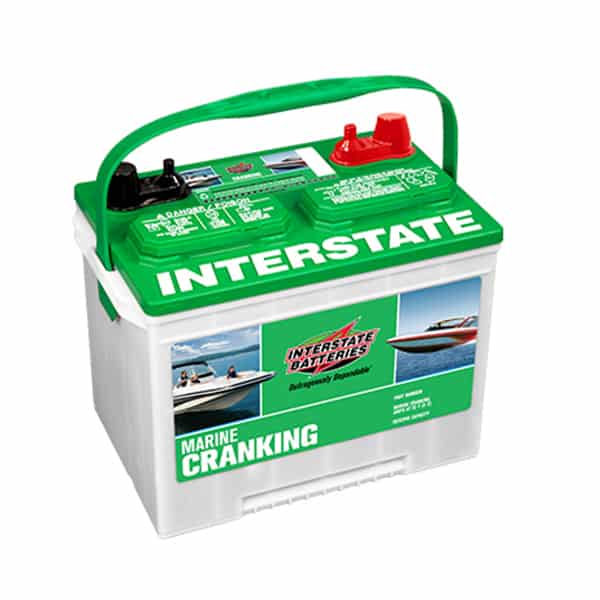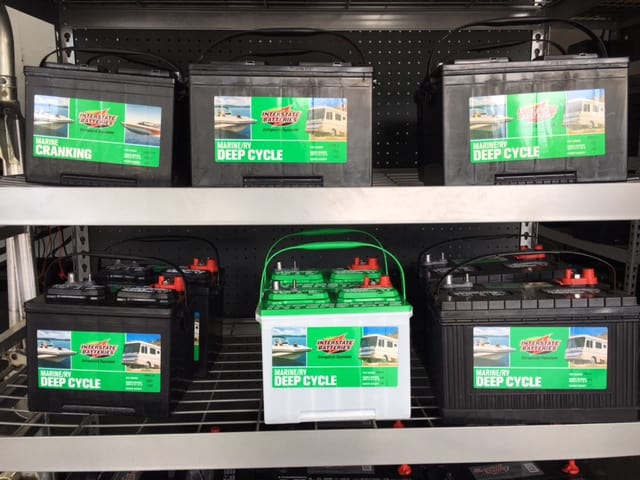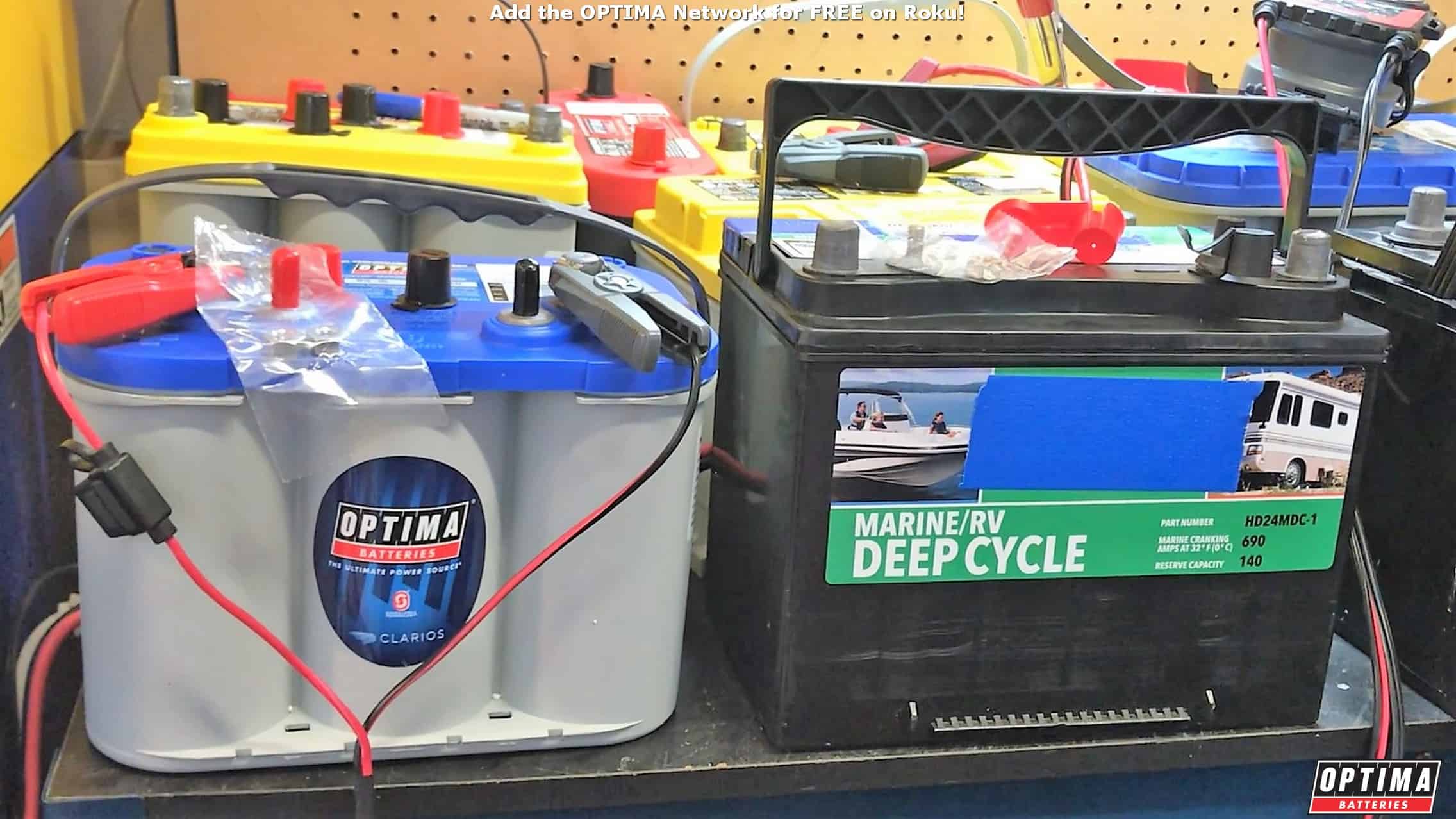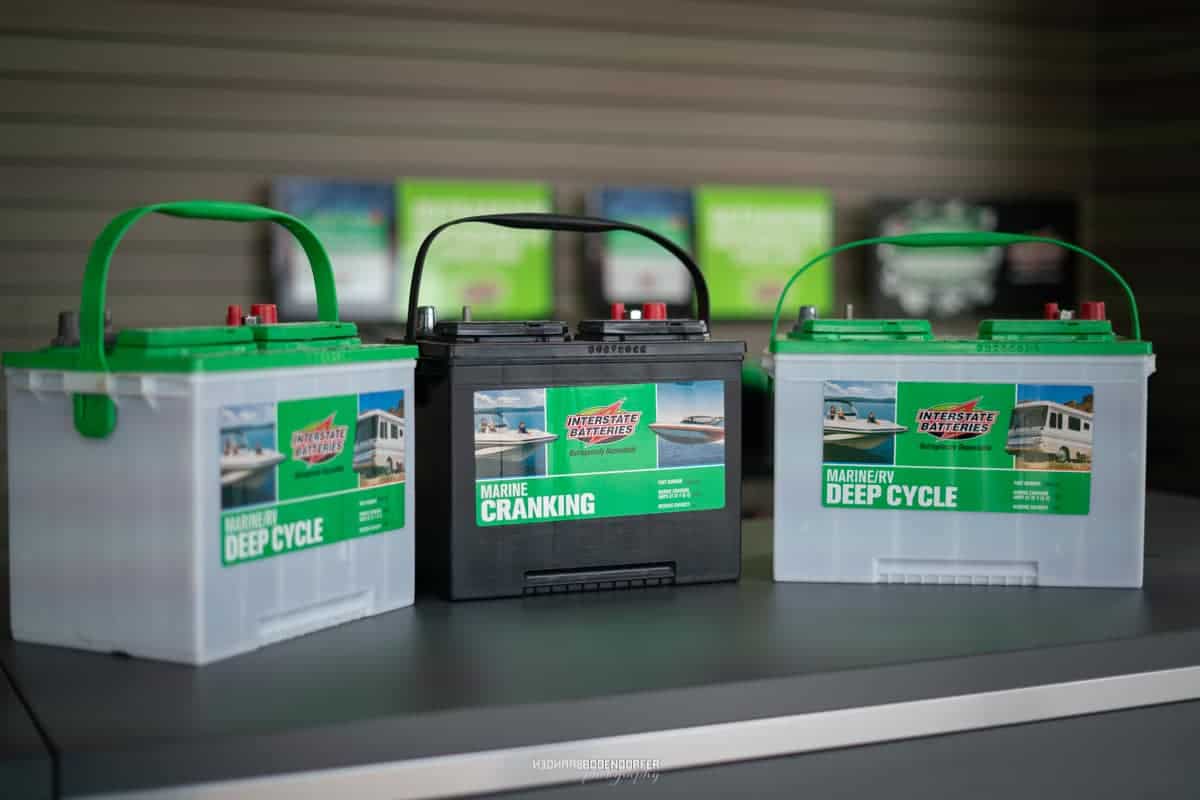Batteries are a crucial part of any vehicle. Cranking marine batteries and deep-cycle marine batteries are both integral to boat owners.
Read on to learn more about cranking vs. deep cycle marine battery options and what is best for your needs as a boater!
Table of Contents
Cranking Marine Battery: Explained

A cranking marine battery is designed to provide high electrical power for a short period to start your boat’s engine. The batteries are known as marine starting batteries.
1. Ignition
When you turn the key in the ignition, your vessel starter motor needs a lot of currents to get the engine going. This strong burst of energy is provided by the starter battery. Once the trolling motor runs, the alternator takes over and provides your car’s power.
2. Depth Of Discharge (DOD)
You cannot use these batteries for a long period of time due to their high depth of discharge (DOD) rate. This initial burst of energy only discharges the battery by 1-3%, after which it is topped up by the alternator.
Typically, cranking batteries are made with thin plates to create more surface area and provide more power.
3. Life Span
These batteries also have a shorter life span than deep-cycle marine batteries as they are not meant to be used for long periods. If you try to use a cranking battery as a deep cycle battery, you will shorten its lifespan significantly.
You can check the battery’s Cold Cranking Amps (CCA) rating as it’s a good indicator of its cranking ability.
4. Load
Another important factor to consider is how long the battery can power a given load. When choosing a starting battery, consider both the CCA rating and the amp-hour storage capacity to ensure that the battery can meet your specific needs.
Deep Cycle Marine Battery: Explained

A deep-cycle marine battery is a lead-acid battery designed for repeated discharges and recharges over extended periods.
Unlike lead-acid batteries, deep-cycle marine batteries are designed to withstand regular cycling without damaging the electrodes or reducing the battery’s overall capacity. This makes them ideal for applications requiring a high discharge level, such as electric golf carts or trolling motors, radios, GPS units, fish finders, and other gadgets.
Deep-cycle marine batteries also have a higher vibration and shock tolerance than lead-acid batteries. This makes them ideal for use in boats and RVs, where regular movement can damage other batteries.
Deep cycle batteries are slow and steady sources of power. They have limited instant power, which is why they cannot be used to start engines.
Deep-cycle marine batteries have a thicker plate construction that can withstand high temperatures, making them less likely to overheat during heavy currents.
1. Gel Deep Cycle Marine Batteries
Gel deep cycle batteries are made with a gel electrolyte instead of the traditional lead-acid electrolyte. This makes them more resistant to vibration and shock and can also be used in a wider range of temperatures.
Gel batteries are maintenance-free and have a longer lifespan than deep-cycle batteries.
2. LiFePO4 Deep Cycle Marine Batteries
The LifePO4 battery is a newer type of deep-cycle marine battery that offers several advantages over other types of batteries.
The biggest advantage of the LifePO4 battery is its weight; these batteries can reduce the overall weight of your boat by up to 70%. In addition, LifePO4 batteries recharge faster than other types of batteries, and they are also leak- and maintenance-free.
3. AGM Deep Cycle Marine Batteries
AGM battery is made with an absorbent glass mat (AGM) separator instead of the traditional lead-acid separator. The AGM separator holds the electrolyte in place, making the battery spill-proof and leak-proof.
Which Battery Is Right For My Boat? Cranking Battery Vs. Deep Cycle

The type of battery you need for your boat depends on how you plan to use it. A starter battery is all you need if you only need a battery to start the boat’s engine.
These starter batteries are designed for short, powerful bursts of energy and will not last long if you try to use them for other purposes.
However, if you plan to use your boat for continuous use that can power accessories such as lights, radio, or GPS, you will need a deep cycle battery. These batteries supply steady power for an extended period and will last much longer than a cranking battery.
Internal plates are used in batteries to augment the area in which reactions can occur. This increases the overall capacity of the battery.
A DOD is the percentage of its capacity that can be used before it needs to be recharged. Different types and uses of batteries will affect how deep the discharge is.
The depth of discharge is an important factor when choosing a battery. It will affect the overall life span of the battery.
The Reason You Can’t Crank And Troll With One Battery
Cranking and deep-cycle marine batteries are both designed for different uses and are not interchangeable. Deep-cycle marine batteries will not last as long as cranking batteries and are more likely to break if used to start your boat’s engine.
Using these batteries is not a good idea to start your boat. Deep-cycle marine batteries are to be discharged and recharged frequently, whereas cranking marine batteries provide quick bursts of energy and then must be recharged.
You Can Opt Dual Purpose Marine Batteries
Dual-purpose batteries can reduce the boat’s total weight, but aren’t always a great fit.
Dual batteries can be expensive and unreliable but still, this battery might work well for some expeditions.
What To Consider While Buying New Marine Battery
When shopping for a new marine battery, there are a few things to remember.
1. Battery Type
Choose the right battery type first.
2. Power
The next thing to consider is the necessary power. This will be determined by the size of your boat and the accessories you use. A small boat with a few accessories will need a battery with less power than a large boat with many accessories.
3. Plate Surface Area
You’ll also want to take into account the plate surface area. This part of the battery comes into contact with the charging system and is responsible for holding the charge. A battery with a larger plate surface area can hold a charge for longer.
4. Voltage
Voltage is also important; you will need a 12-volt or 24-volt battery, depending on the size of your boat.
5. Amp Hours
Finally, you’ll want to consider the number of amp hours. This is the number of times you can recharge your battery before it needs to be replaced. A higher number of recharge cycles means your battery will last longer.
When buying a new battery, compare the necessary power, plate surface area, and several recharge cycles to find the best option. If you have lots of electronics on your boat, you will want a battery with high amp hours.
Battery Troubleshooting Tips
When it comes to your boat’s battery, you must take good care of it. With proper maintenance and care, you can extend the life of your battery and avoid any problems while out on the water.
- Inspect the battery regularly for any damage or corrosion.
- Avoid overcharging the battery by using a slow overnight charger.
- Avoid continuous power output even when not in use.
- Total discharge of your battery can damage it, so avoid this.
- Avoid charging your battery when it is hot.
- Use a marine battery switch. This will help you conserve your battery power and prevent accidental discharge in the long run.
FAQ
1. When to Replace the Battery For Boats?
Like any other type of battery, marine batteries will eventually need to be replaced. Depending on the model of your boat and how frequently you use it, a battery can last anywhere from two to six years.
There are a few telltale signs that it might be time for a new battery, such as if it’s losing power more quickly than usual or if the boat is having trouble starting.
2. How To Charge A Marine Battery?
It’s important to keep your marine battery properly charged to last as long as possible. The best way to do this is to invest in a quality charger. These chargers will automatically shut off when full to prevent overcharging, which can shorten the life of your battery.
When charging your marine battery, follow the manufacturer’s instructions. Generally, it’s best to charge the battery slowly overnight, so it doesn’t become overcharged. However, some batteries require a different charging method, so always consult the manufacturer’s instructions before charging.
If you notice your battery isn’t holding a charge as well as it used to, have a professional inspect it. They can determine whether the problem is with the battery or the charging system and make the necessary repairs.
Final Thoughts
A marine battery is a necessity for any boat, and you must choose the right one for your needs. A deep cycle battery is a way to go if you’re looking for a battery with reserve capacity. A cranking battery is your best bet if you need a battery that can handle frequent starts and stops.
Whichever type of marine battery you choose, ensure it’s compatible with your boat and your needs.
